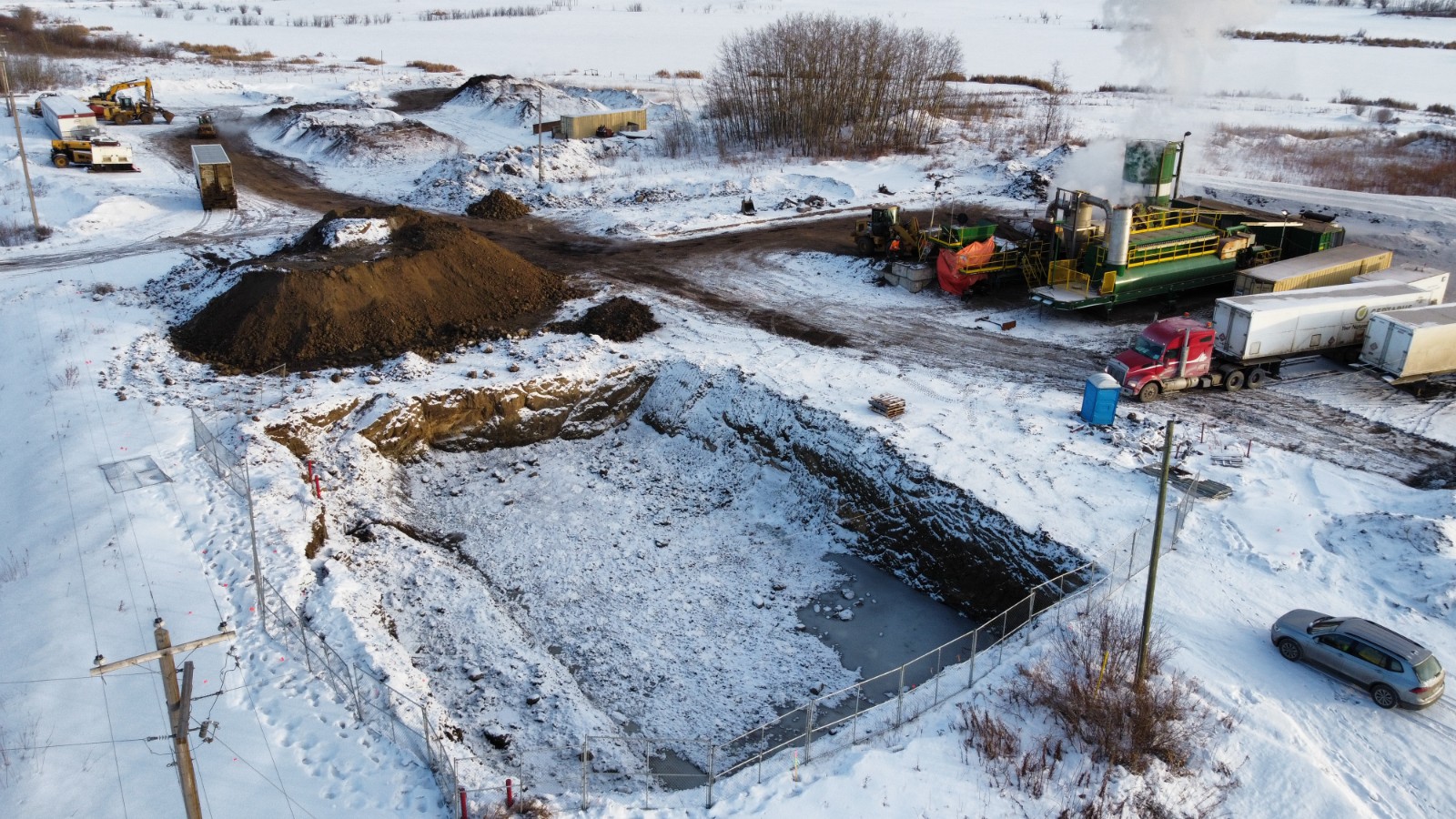30541-100 Ave. Acheson, AB.
Head Office: Edmonton, Alberta Canada
info@NERglobal.com
Business Hrs. 08:00-18:00 MST
Tel: 1.888.960.8222
International Toll Free
Head Office: Edmonton, Alberta Canada
Business Hrs. 08:00-18:00 MST
International Toll Free

Nelson Environmental Remediation Ltd. is a leading provider of on-site, ex-situ thermal soil remediation, specializing in the treatment of hydrocarbon and organic compound-contaminated soils. As a pioneer in mobile thermal desorption technology, we deliver clean soil ready for beneficial reuse—efficiently, sustainably, and reliably.
From our headquarters in Edmonton, Alberta we mobilize treatment solutions to tackle the toughest environmental challenges locally, nationally, and worldwide. With regional offices or sister companies in The United States, Asia and Europe we are positioned to work with your regulator effectively.
With over 30 years of global project experience, Nelson is a recognized leader in environmental remediation. Our innovative systems have delivered successful site rehabilitations in extreme climates, isolated sites, densely populated urban environments, worldwide.
At Nelson, our highly experienced team are committed to guaranteed results. We work with governments, corporations and military clients to clean up emergent and legacy environmental impacts. Our liability destruction mentality leads our clients to rely on us when they need to repurpose the impacted soil or end site management.
Our prioprietary Mobile Thermal Desorption technology , paired with industry-leading and proven performance fuels our growth and innovation. We are actively advancing research into emerging contaminants and new environmental challenges.
Direct-fired Thermal Desorption is an ex-situ process for the remediation of soils with organic contamination with low levels of contamination by volume.
Contamination is vapourized, transported away from the soil and destroyed. Clean soil is hydrated and returned to owner for beneficial reuse.
Indirect-fired Thermal Desorption is an ex-situ process deployed when concentrations of contamination create a risk of explosive atmosphere.
When your soil or other waste stream has high levels of contamination, including free product, selecting Indirect Thermal Desorption allows you to mitigate risk of explosion in an oxygen deprived environment. The resultant flue gas can be recycled and condensed or destroyed at Client request.


Nelson’s fully mobile units eliminate the need for transporting contaminated soil off-site, which significantly reduces liability, regulatory hurdles, and transportation costs. By treating the material directly at your location, we streamline the process, minimize handling risks, and accelerate project timelines.
Our thermal treatment system prevents direct contact between combustion and soil, maintaining soil structure and minimizing the loss of valuable minerals. This ensures that treated soil can be safely reused on-site, meeting strict environmental standards while reducing the need for costly backfilling or soil replacement.
Nelson’s systems feature precise temperature controls and adjustable residence times, allowing for tailored treatment based on contamination severity and soil composition. This flexibility ensures optimal removal of volatile and semi-volatile contaminants while maximizing energy efficiency and throughput.
Our systems incorporate advanced emissions control technologies, such as thermal oxidizers and filtration systems, to minimize air pollutants and meet stringent environmental regulations. Additionally, our team stays ahead of industry standards, continuously refining our processes to align with the latest regulatory and sustainability best practices.
Mobile Thermal Desorption mobilizes harmful contaminants to extract them from soil, without exposing the soil to flame or chemical additives.
Following Thermal Desorption, topsoil that has been treated has been shown to have increased water and nutrient retention and in certain cases a reduction in invasive seedloading. Retain your topsoil for re-use in the event of an oil spill, PFAS contamination or other such incidents and preserve this precious non-renewable resource.
Managing moisture and temperature is important in compaction activity. From -40 C in Canada’s arid northern climate to +40 C in Hawaii’s tropical climate, Nelson returns soil that is rehydrated to a specification and compactable in any ambient temperature.
By removing contaminants to below regulatory limits and returning those contaminants to their atmospheric components, the long-term liability associated with storing waste in landfill is not required.
Thermal Desorption is recognized internationally as the Best Available Technology (B.A.T.) for the remediation of organic pollutants in soil. It’s combination of efficient, cost effictive, and safe implementation make it a gold standard.
Mobile Thermal Desorption has been endorsed by top environmental agencies, including the U.S. Environmental Potection Agency (U.S. EPA) and the European Environment Agency (EEA), alongside various national regulatory bodies for other countries.
Soil Feed System
Excavated soil is prepared for treatment by various methods of screening and shredding to remove oversize aggregate and debris. Soil is homogenized to uniform contaminant and moisture levels. Prepared soil is fed into a feed hopper metering soil on to a conveyor weigh belt scaling tonnage feed rate and tallying total tonnage. The soil is conveyed into the rotary dryer desorber.
Rotary Dryer Desorber
The primary thermal treatment component is a rotary dryer desorber. Soil is fed into the desorber where flights lift and veil the soil through the hot gas stream produced by the
direct‐fired primary burner. Soil flows counterflow to the gas stream passing through the desorber. The soil discharges from the desorber at temperatures ranging up to 550C
(1000F) depending on boiling points and criteria to achieve regulatory objectives.
It is important to note the dryer desorber is not an incineration process, but it is an evaporative extraction process volatilizing organic contaminants for physical separation from the soil. This results in high-quality remediated soil for beneficial reuse restoring sites to the highest value use for natural areas, agricultural, residential, commercial or industrial redevelopment.
Primary Fuel System
The rotary desorber is heated via a direct‐fired burner. Burners will operate on natural gas, liquid propane, liquid natural gas, heating oil, diesel fuel, kerosene, recycled fuel oil etc. The burner is sized according to the sizing of the chamber achieving production capacity. A centrifugal blower supplies combustion air to the burner.
Treated Soil Handling System
The heated clean soil from the thermal desorber is discharged into a rotary drum quench system. The remediated soil and particulate from the baghouse are blended and cooled with a water spray. Water use in the treated soil handling system is dependent on the temperature and soil type as moisture content is reestablished in a range of 5% to 10%. The treated soil is discharged from the quench system and staged in segregated piles representing production increments pending confirmatory analytical.
Baghouse Operation
The volatilized organics, steam, particulate and combustion gasses are drafted from the rotary dryer through a cyclone or knockout chamber
where larger particles drop out. The gas stream then flows to the baghouse. The baghouse captures fine particulate and drops it into an auger system returning the particulate to the soil stream in the quench system. Particulate removal from the baghouse filter media is achieved by compressed air reverse‐flow pulsation.
An induction fan creates negative air pressure drafting gasses through the baghouse. The ID fan then discharges a gas stream into the thermal oxidizer.
Thermal Oxidizer
The gas stream flows through a thermal oxidizer destructing organics via thermal oxidation at temperatures exceeding 870C (1600F) with a DRE (destruction removal efficiency) of 99.99+%. The thermal oxidizer consists of a refractory lined combustion chamber with a retention time of 1‐2+ seconds depending on the system design.
The oxidizer has a direct‐fired burner creating the initial temperature for destruction. As the dryer desorbs organics, a substantial part of the ongoing fuel requirement may be provided by the organic contaminant forming part of the fuel source maintaining the minimum temperature requirement for emission compliance.
Our Direct Fired systems have customizable capacity based on the impacts we’re asked to treat and the conditions in which we are working. For general guidance our estimated system throughputs in optimal conditions are:
The major components of ITD systems consist of a control room, a material feed system with a belt weigh scale, 3 rotary dryers, a high-temperature baghouse, a condensation recovery system and a thermal oxidizer. System specifications are provided in the following description:
Feed System
The primary hopper/feeder and conveyor deliver prepared feedstock to the secondary feed hopper providing continual feed to the dryers.
Feedstock is prepared to a small aggregate size to optimize material flow and heat transfer within the dryer.
Rotary Dryers
Dryers are designed to heat the waste stream by radiation and conduction from the heated dryer shell. The desorber burners heat the external surface of the dryer transmitting energy
through the shell to heat waste stream indirectly volatilizing organics. The dryer shell is sealed at both ends to prevent ambient air leakage from entering the drying process. The dryer is
maintained under negative pressure to prevent fugitive emissions.
Safety System and Inert Gas
Most importantly, the dryer is maintained at a very low oxygen level with purge nitrogen from a nitrogen generator to inert the dryer preventing autoignition..
Particulate Capture
The volatilized organics and steam with particulate exit the dryer drafted into a high-temperature filtration system to capture particulate.
A reverse pulse system employs nitrogen to release solids collected on the filters dropping them into the discharge system with the main solids from the dryer.
Treated Solids Handling System
The hot clean solids exit the dryer into a quench system with water spray to cool and rehydrate solids.
The treated solids are discharged from the quench system and staged in segregated piles representing production increments pending confirmatory analytical.
Gas Treatment
The dryer gas stream is drafted from the particulate filter system to the heat exchanger condensation recovery system.
Heat Exchanger
Plate heat exchangers cool gas stream condensing and recovering organics and water. Recirculating cooling water flows through the clean sides of the plates while gases condense to liquid on the other side and collect in tanks. Cooling water and recovered fluids do not come into contact with each other.
Cooling Tower and Condenser
Evaporative cooling towers provide a cooled recirculating waster. Condensable hydrocarbons are optionally recovered for recycling or reuse.
Thermal Oxidizer
Non‐condensable organics then flow through a thermal oxidizer destructing organics via thermal oxidation at temperatures exceeding 870C (1600F) with a DRE (destruction removal efficiency) of 99.99+%. The thermal oxidizer consists of a refractory-lined combustion chamber with a direct-fired burner.
Throughput and capacity for the indirect thermal treatment plants are highly dependent on the concentrations of hydrocarbons, planned mode of recovery or destruction, and available utilities. Please contact us to recieve a customized work plan if you have a site with high concentrations of organic contaminants, such as a tailings pond or free product spills.

NELSON has been recognized as a leader in the environmental industry for its ability to complete some of the largest soil remediation projects worldwide.
International Toll Free Support
Stay up-to-date on the latest news and technologies in Global Remediation.
30541-100 Ave. Acheson, AB. Canada T7X 6L8
© 2025 Nelson Environmental Remediation.